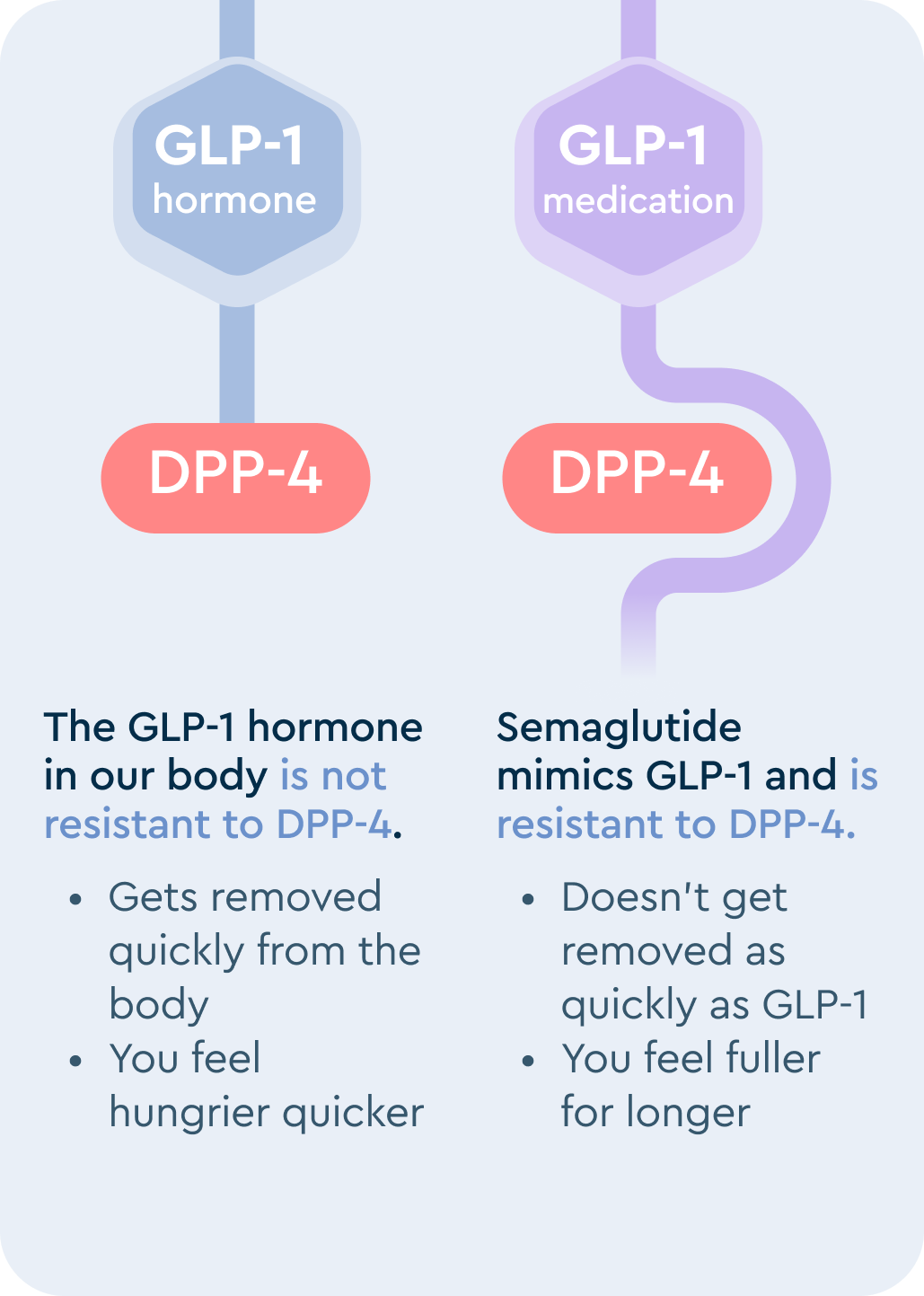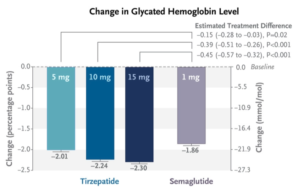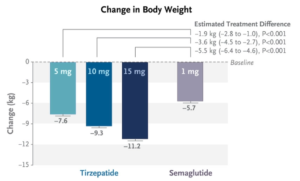Jump to: GLP-1s for type 2 diabetes | GLP-1s for weight loss | Side effects and safety | Take home message
GLP-1 receptor agonists (GLP-1s) are a class of medications approved for individuals living with type 2 diabetes and obesity to help lower blood glucose levels (blood sugar) and support weight loss.
Currently, the most popular GLP-1s available in the UK are Mounjaro and Wegovy.
Second Nature has launched a Mounjaro weight-loss programme and a Wegovy weight-loss programme to help people kickstart their weight loss and cement healthy habits for life.
GLP-1s like Wegovy and Mounjaro have four mechanisms to improve blood sugar levels and support weight loss:
- Improve insulin function: Improving insulin response to glucose from meals enables the body to move glucose from the blood and into the cells (like muscle cells) to be burnt for energy or stored as glycogen.
- Prevents over-secretion of glucagon: Glucagon is a hormone that tells the liver to send more glucose into the bloodstream when blood sugar levels are low. However, in individuals with type 2 diabetes, this doesn’t function properly, and glucagon is overactive. In this scenario, preventing excess glucagon secretion helps lower blood sugar levels.
- Slows down gastric emptying: Gastric emptying refers to the rate that food moves from the stomach and into the small intestine. Slowing down this process makes us feel fuller for longer, leading to lower calorie intake. Weight loss independently improves blood sugar levels.
- Signalling in the brain: GLP-1 acts on the brain – specifically the hypothalamus, which regulates appetite – to increase satiety and lower appetite. GLP-1s mimic this action.
A short history of GLP-1s
In 1987, researchers discovered a hormone derived from the gut that supported insulin release to manage blood sugar levels known as glucagon-like peptide 1 (GLP-1).
GLP-1 was shown to manage blood sugar levels by improving insulin function, lowering glucagon levels, and delaying gastric emptying.
However, research showed that GLP-1 was removed from our bloodstream quickly and had a half-life of two minutes as it’s degraded by an enzyme called DPP4.

However, the innovations of GLP-1s meant they could mimic the hormone GLP-1 and be resistant to the DPP4 enzyme, so they had a lasting impact on blood sugar levels and appetite.

In 2005, the first GLP-1 receptor agonist received FDA approval in the U.S. and was brought to market for individuals living with type 2 diabetes. In the UK, the drug was approved in 2007.
Since then, more than ten types of GLP-1 receptor agonists have received FDA approval and been brought to market, and with each new version, their effectiveness has increased.
This guide will mainly focus on the three more-recent long-lasting forms of injectable GLP-1s:
- Liraglutide (Saxenda)
- Semaglutide (Ozempic, Wegovy)
- Tirzepatide (Mounjaro)
Should I take GLP-1 drugs?
For individuals living with type 2 diabetes, research has shown that GLP-1s can be highly effective at reducing blood sugar levels and improving glycemic control. Particularly the more recent versions semaglutide, tirzepatide, and liraglutide.
Additionally, if you’re living with obesity and struggling to lose weight, GLP-1s effectively support clinically significant weight loss of more than 10% of body weight. Particularly semaglutide and tirzepatide.
However, whether you should be on any medications depends on your current situation, your physiology, and what medications you’re currently taking.
Any medication decision for type 2 diabetes should be made alongside the support of your doctor and healthcare team, as the rewards are associated with risks.
For example, if you’re taking insulin as part of your medication plan, taking GLP-1s alongside this without appropriate changes in your insulin dose could lead to diabetic ketoacidosis. A life-threatening situation that should not be taken lightly.
There are also common side effects in all classes of GLP-1s. Some of these will be mild, like flatulence, cramping, or constipation, whilst others can be more severe.
Not a magic pill
These medications are designed to be taken alongside weight-loss interventions to improve your lifestyle and shouldn’t be considered lifelong medications.
Instead, they should be used to help you kickstart your weight loss and health journey while you commit to living a healthier lifestyle.
We’re not about a quick-fix crash diet that doesn’t educate you on how to lead a healthier lifestyle. We want you to take control.
We’ve been working in the NHS since 2017, supporting people to lose weight and manage their type 2 diabetes.
In 2022, the NHS published data comparing five different providers of the Digital Diabetes Prevention Programme.
The results demonstrated that Second Nature was more than twice as effective at supporting weight loss after 12 months than the four other providers.

For the right person, adding GLP-1s to a lifestyle programme will help them achieve significant weight loss results and improve their health in the long term.
Otherwise, keep reading as we examine the science behind GLP-1s, their effect on weight loss and type 2 diabetes, and their side effects.
1) GLP-1s for type 2 diabetes
The hormone GLP-1 binds to GLP-1 receptors in the pancreas to increase insulin release after a meal. It also prevents the body from releasing too much glucagon, a hormone that increases blood sugar levels.
These two mechanisms support individuals living with type 2 diabetes in managing their blood glucose levels on a meal-to-meal basis.
Research has shown that GLP-1s effectively reduce blood glucose in people with type 2 diabetes.
Liraglutide (Saxenda) was one of the earlier forms of longer-lasting GLP-1s and reduces HbA1c (average blood glucose) levels by around 1.3% on average and fasting plasma glucose by 2 mmol/L.
In comparison, semaglutide (Ozempic) reduces HbA1c by around 1.8% on average and fasting plasma glucose by 2.8mmol/L.
Semaglutide (Ozempic/Wegovy) is more effective at reducing blood sugar levels than liraglutide (Saxenda). Interestingly, a new version of GLP-1s known as tirzepatide (Mounjaro) may be more effective than semaglutide.
Tirzepatide is a dual-action type 2 diabetes medication. Alongside its effects on GLP-1, it also mimics the actions of another hormone called GIP (gastric inhibitory polypeptide) that reduces blood sugar levels.
A randomised controlled trial in 1,897 individuals living with type 2 diabetes compared the impact of three doses of tirzepatide (5mg, 10mg, and 15mg) compared to a once-weekly injection of 1mg semaglutide (Ozempic) on blood sugar levels.
The results showed that all three doses of tirzepatide led to more significant HbA1c reductions than 1mg of semaglutide.

Tirzepatide hasn’t been compared to the higher dose of semaglutide (Wegovy) now available.
However, researchers have compared the impact of both drugs from different studies (this is called an indirect analysis) and suggested that the higher doses (10mg and 15mg) of tirzepatide might reduce HbA1c by 0.36% more than 2mg of semaglutide.
In comparison, there was no difference between 5mg of tirzepatide and 2mg of semaglutide (Wegovy).
Liraglutide and semaglutide are available in the UK and the U.S. to treat type 2 diabetes.
However, tirzepatide is only available in the U.S. after getting FDA approval in 2022. Although it’s likely the UK will approve tirzepatide in the not-to-distant future.
So, GLP-1 receptor agonists significantly reduce blood sugar levels and are an effective treatment for type 2 diabetes—particularly the longer-lasting and recent versions of GLP-1s, semaglutide and tirzepatide.
Key points
- GLP-1 is a hormone that increases insulin release and prevents the release of too much glucagon, helping manage blood glucose levels in individuals with type 2 diabetes
- GLP-1 receptor agonists, such as liraglutide and semaglutide, effectively reduce blood glucose levels
- Semaglutide is more effective than liraglutide at reducing blood sugar levels
- Tirzepatide is a newer GLP-1 receptor agonist that also mimics the actions of another hormone called GIP, which can also reduce blood sugar levels
- A randomised controlled trial showed that tirzepatide led to more significant blood sugar reductions than semaglutide across three doses
- Tirzepatide may be more effective than semaglutide at higher doses, but this needs further investigation
- Liraglutide and semaglutide are available in the UK and the US, while tirzepatide is only available in the US but is likely to be approved in the UK soon.
2) GLP-1s for weight loss
Interestingly, the lasting effect of GLP-1s to support type 2 diabetes might be its impact on reducing appetite and supporting weight loss than the impact it has on the pancreas.
The hormone GLP-1 is also a neurotransmitter and communicates directly with an area in the brain that regulates appetite, called the hypothalamus.
Additionally, GLP-1 delays gastric emptying and leads to gut distension (an expansion of the gut). Both of these effects slow down the rate at which food is digested and make you feel fuller.
GLP-1s mimic these actions and, as they’re resistant to the enzyme DPP4, have a longer-lasting impact on our appetite.
Compared to lifestyle interventions without medications, GLP-1-assisted programmes have been shown to lead to a more clinically significant weight loss of 10% or more.
Losing and maintaining weight loss of more than 10% is associated with significantly reducing complications associated with obesity, including hypertension, type 2 diabetes, and heart disease.
A recent paper published in The Lancet showed that nearly 20% of participants in lifestyle interventions without medications gain weight, around 40% lose between 1-10% of their body weight, and just 13% lose more than 10%.
In comparison, less than 5% of participants combining semaglutide with lifestyle interventions gain weight, around 10% lose between 1-10%, and 87% lose more than 10%.
So, 47% more people lose more than 10% of body weight on lifestyle interventions with semaglutide compared to lifestyle interventions alone.
Comparing the different versions of GLP-1s, semaglutide is more effective at supporting weight loss than liraglutide.
A randomised controlled trial was conducted in 2022 investigating the impact of semaglutide and liraglutide on weight loss in individuals living with obesity.
The results showed that the participants in the semaglutide group lost 15.8% of their body weight compared to 6.4% in the liraglutide group.
Interestingly, recent trials have shown that tirzepatide is more effective than semaglutide.
A randomised controlled trial in 1,897 individuals living with type 2 diabetes compared the impact of three doses of tirzepatide (5mg, 10mg, and 15mg) compared to a once-weekly injection of 1mg semaglutide (Ozempic) on blood sugar levels.
The results showed that all three doses of tirzepatide led to more significant weight loss than 1mg of semaglutide.

As mentioned above, tirzepatide hasn’t been compared to the higher dose of semaglutide (Wegovy) now available.
However, researchers have compared the impact of both drugs from different studies and suggested that the higher doses (10mg and 15mg) of tirzepatide might reduce weight by 5.15kg more than 2mg of semaglutide.
In comparison, there was no difference between 5mg of tirzepatide and 2mg of semaglutide.
So, GLP-1s lead to clinically significant weight loss rarely observed in intervention trials that use lifestyle interventions without medications.
Semaglutide is more effective than liraglutide, and tirzepatide appears more effective than semaglutide.
Key points:
- GLP-1s (glucagon-like peptide-1 receptor agonists) support type 2 diabetes by reducing appetite and supporting weight loss alongside their effects on the pancreas
- GLP-1-assisted programmes lead to a clinically significant weight loss of 10% or more, which can significantly reduce complications associated with obesity
- Combining semaglutide with lifestyle interventions leads to significantly more weight loss than lifestyle interventions alone, with 87% of participants losing more than 10% of their body weight
- Semaglutide is more effective at supporting weight loss than liraglutide
- Tirzepatide is more effective than semaglutide at reducing weight, with all three doses of tirzepatide leading to more significant weight loss than 1mg of semaglutide
- The higher doses of tirzepatide (10mg and 15mg) might reduce weight by 5.15kg more than 2mg of semaglutide, while there appears to be no difference between 5mg of tirzepatide and 2mg of semaglutide
3) Side effects and safety
All medications have possible side effects, particularly if you live with other health conditions.
Some will be mild but uncomfortable, such as cramping, and others will be more severe, such as shortness of breath. You must report any side effects you experience to your doctor and healthcare team when on medications.
Interestingly, the medications that may be the most effective at achieving the desired outcome can be the ones that are more likely to cause adverse effects.
A meta-analysis compared the impact of liraglutide and four other medications we haven’t reviewed in this guide on weight loss and the risk of adverse effects.
The results showed that while liraglutide was more effective at supporting weight loss, you were also more likely to discontinue the medication due to the severity of the side effects and adverse events.
Similarly, tirzepatide is more effective at supporting weight loss than semaglutide but seems to have a poorer safety profile.
In a randomised controlled trial with over 1800 participants comparing tirzepatide to semaglutide, the tirzepatide group reported more serious adverse events (5-7% VS 3%) and higher discontinuation rates due to adverse events (6-8.5% VS 4%).
Additionally, there were more deaths in the Tirzepatide group than semaglutide (12 vs 1). However, the researchers confirmed they didn’t believe these deaths were linked to the medication.
Conversely, semaglutide is more effective at supporting weight loss than liraglutide but is better tolerated, according to a recent randomised controlled trial.
13.5% of participants in the semaglutide group discontinued their treatment due to side effects, compared to 27.6% with liraglutide.
Over 80% of participants in both groups reported GI-related issues such as constipation, cramping, bloating, and diarrhoea.
So, typically the more effective the medication, the more likely the risk of adverse events. The exception is semaglutide which seems to have a better safety profile than the other GLP-1s available.
A rare and severe side effect of liraglutide is the development of thyroid cancer. If you have a family history of thyroid cancer, you shouldn’t take liraglutide.
Generally, GLP-1s are well tolerated and don’t appear to cause severe adverse events in most people, particularly semaglutide.
However, there are examples of drugs being withdrawn from the market as more long-term data comes to light.
Lorcaserin was a weight loss drug approved by the Food and Drug Administration (FDA) in the U.S. but was recently withdrawn as data indicated that it increased cancer risk.
The example of lorcaserin is why you must weigh the pros and cons when your doctor prescribes this medication or before you purchase it yourself and start treatment. Report any side effects to your healthcare team.
It’s important to note that it’s generally not recommended for women to take GLP-1s or other weight loss medications while looking to get pregnant, are currently pregnant, or are breastfeeding.
Key points:
- All medications have possible side effects, especially if you have other health conditions.
- Mild to severe side effects can occur, and you should report them to your doctor and healthcare team.
- Medications that are most effective may have a higher risk of adverse effects.
- Liraglutide and tirzepatide are effective for weight loss but have a poorer safety profile and higher discontinuation rates due to adverse events.
- Semaglutide is well tolerated and more effective for weight loss than liraglutide.
- GLP-1s are generally safe, but some drugs have been withdrawn from the market due to long-term risks.
- Women should not take GLP-1s or other weight loss medications while pregnant, breastfeeding, or trying to conceive.
Take home message
Weight-loss injections are designed as additional tools for weight management interventions and shouldn’t be considered lifelong medications.
Instead, they should be used to help you kickstart your weight loss and healthy journey while you commit to living a healthier lifestyle.
Consider the use of antidepressants for people living with depression. They’re not designed to cure the condition. Instead, they’re designed to allow room for therapy to treat the condition’s underlying cause.
Mounjaro, and other weight loss injections, like Ozempic and Wegovy, are similar. They can allow you to make lifestyle changes to support long-term weight loss maintenance.
Mounjaro can help silence food-related thoughts and also give you a boost of confidence with more immediate weight-loss results.
This helps to buy you the time and headspace to understand why your body may have struggled to lose weight previously, and to build new long-term healthy habits.
The core focus of our medication programmes is to calm down the feeling of food noise, lower your cravings, and allow you to build healthier habits to keep the weight off for good.
The ultimate goal is to make losing weight feel second nature.
Second Nature’s medication programme
Second Nature currently provides Mounjaro as part of our Mounjaro weight-loss programme.
Why should you choose Second Nature over other medication providers if you’ve decided to try Mounjaro (assuming you’re eligible)?
For peace of mind.
Second Nature has worked with the NHS for over 6 years providing weight-loss programmes across the UK.
While our Mounjaro weight-loss programme is private and not currently used by the NHS, we’ve built the programmes focusing on scientific evidence, patient safety, and data security.
We hope that our 6+ years of working with the NHS and building a track record of effective weight-loss results will give you peace of mind to give us a try.
Please note: We generally recommend speaking with your GP/doctor before you start taking any new medication like Mounjaro. If you do sign up for Second Nature's Mounjaro programme, then we'll also send your GP a letter to let them know you've started a medication-supported weight-loss journey.








